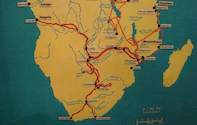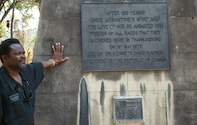
David Livingstone was born into poverty and from the age of 10 was sent to work in a mill in his hometown of Blantyre in Scotland. By balancing books on the loom while weaving, he educated himself so well he won a scholarship to study medicine in Glasgow and then London.
On graduating he joined the London Missionary Society (LMS) and in 1841 was sent to South Africa where he journeyed into the dry interior. There he set about working at the Kuruman mission station under the directorship of John Moffat where he met and courted Moffat's daughter Mary.
His sponsors in the LMS did not seem to mind that he had failed in his primary task of converting African heathens to Christianity (records show that he did in fact make one convert in all his travels). What he was accomplishing, on the other hand, was opening up the African hinterland, tackling the slave trade and creating a new sphere for British influence and trade.
He had a dream of using the Zambezi River as a shipping highway, the Batoka Plains to the north becoming a fertile source of cotton, with oilier commodity crops and commercial food growing. The fact that the plain proved to be infertile and full of malaria was only a part of his problems.
Then there were the perils of the river itself. Although he noted the apprehension of his African guides as he approached the falls, steeped in local lore and tales of the monster Nyaminyami that lurked below in Batoka Gorge, Livingstone paid them little heed.
On 16, November 1855, his Makololo polers navigated through a maze of channels and islands upstream towards a plume of Pray. "At one time we seemed to be going right into the gulf, but although I felt a little tremor, I said nothing, believing I could face the difficulty as well as my guides."
They landed on a tiny island, known as Goat Island, right at tile very edge of the immense wall of falling water. Livingstone crept through drenching spray to the verge and peered down into the gorge, the view so spectacular that he later immortalised it in his diary as "scenes so lovely they must have been gazed upon by angels in their flight." He added: "No one can imagine the beauty of this view from anything witnessed in England."
On the island, he planted peach and apricot stones, which led to its alternative name of Garden Island, Today you can visit the exact spot where Livingstone first glimpsed the falls, courtesy of the Tongabezi lodge boat that takes you through the fast-moving channels of the Zambezi River to enjoy a very English tea or G&T on what is now known as Livingstone's Island. And you really should try to go, as it certainly is one of the grandest vistas in all of Africa.
How History Will Remember David Livingstone

As history shows, Livingstone was a man who made history suit himself. This probably explains why he named these falls Victoria - the only time he did not use a local African name on his maps - in honour of Queen Victoria. Perhaps it is his rightful due that his is the name that we associate with the discovery of the falls, as he was certainly a remarkable explorer.
Even in his failures (as a missionary and in not pushing on to the falls when first he was in striking distance) he is remembered as the man who, in the words of famous British geologist and explorer JW Gregory, "made the greatest contribution to African geography which has ever been made."
What exactly were those faults? To his fellow expedition members, he lacked what today we might call "good people skills". They used words like ruthless, authoritarian, secretive, spiteful, vindictive, jealous, deceitful and even double-dealing. But as much as his European associates disliked and mistrusted him, just about every African with whom he came into contact virtually worshipped him. In the final analysis, maybe it can be said that Livingstone was as tough on those around him as he was on himself.
Most important, though, was the contribution he made to end the East African slave trade, which at that time was operated from Zanzibar. Although slavery had been abolished throughout the British Empire, it was still widespread across east and south-central Africa trading routes.
It is rather pleasing to know that the evocative name of Mosi-oa-Tunya, "the smoke that thunders” is still in use today. While the national park and town in Zimbabwe is known as Victoria Falls, the national park on the Zambian side is called Mosi-oa-Tunya. It is even nicer to know that the World Heritage List recognises it as Africa's most spectacular waterfall.
By David Bristow

 David Livingstone epitomised the spirit of colonial exploration and spent 33 years travelling through Africa....
David Livingstone epitomised the spirit of colonial exploration and spent 33 years travelling through Africa....